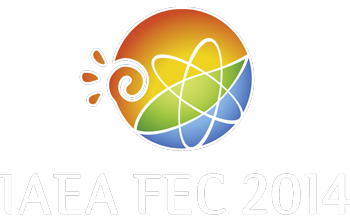Speaker
Mr
Marco Martinez
(CIEMAT)
Description
During ECR heating microwave power is coupled to the electrons whereas ions are only heated through, usually weak, collisional coupling because of the cut-off density limitation. However, contrary to what is expected, significant suprathermal ions have been observed in TJ-II ECRH plasmas by either spectrometry of H_alpha emission [1] and by means of a luminescent probe capable of detecting those suprathermal ions as they escape from the confined plasma [2], [3], with very high sensitivity.
The TJ-II luminescent detector used in counting mode and with energy discrimination [4] has allowed observing changes and spikes in the energy distribution of suprathermal ions, which can be associated with changes in the plasma parameters. The increase of the luminescent detector count (spikes) around certain energies is always observed during ECRH operation and never detected during NBI heating. The ion suprathermal population and its energies are found to strongly depend on whether the ECRH power deposition is on or off-axis. Also, a change of the shape of suprathermal ion distribution function is found when the magnetic field configuration is varied during the discharge. In the present work a detailed analysis is presented on the ion energy spectrum in ECRH plasmas, for fixed and changing magnetic field configuration.
[1] D. Rapisarda, B. Zurro, V. Tribaldos, A. Baciero, et al., Plasma Phys. Controlled Fusion 49, 309 (2007).
[2] D. Jiménez-Rey, B. Zurro, J. Guasp et al., Rev. Sci. Instrum. 79, 093511 (2008).
[3] B. Zurro, A. Baciero, V. Tribaldos et al. Nuclear Fusion 53, 083017 (2013).
[4] B. Zurro, A. Baciero et al., Rev. Sci. Instrum. 83, 10, 10D306 (2012).
| Country or International Organisation | Spain |
|---|---|
| Paper Number | EX/P4-41 |
Author
Mr
Marco Martinez
(CIEMAT)
Co-authors
Dr
Alfonso Baciero
(CIEMAT)
Dr
Bernardo Zurro
(CIEMAT)
Dr
David Jiménez-Rey
(CIEMAT)
Dr
Victor Tribaldos
(Universidad Carlos III de Madrid)

